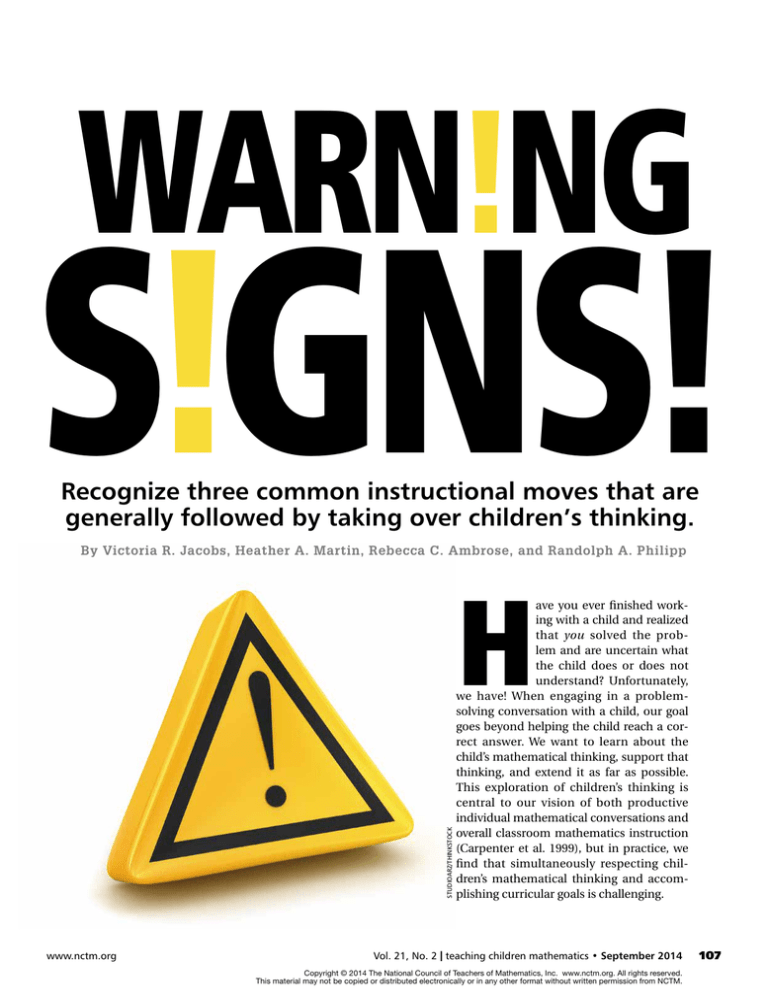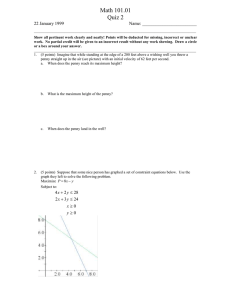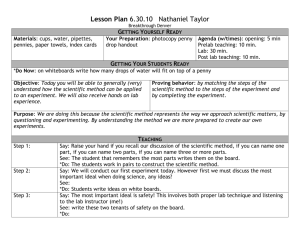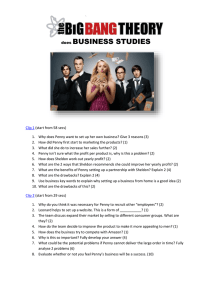
WARN!NG
S!GNS!
Recognize three common instructional moves that are
generally followed by taking over children’s thinking.
By Victoria R. Jacobs, Heather A. Martin, Rebecca C. Ambrose, and Randolph A. Philipp
STUDIOARZ/THINKSTOCK
H
www.nctm.org
ave you ever finished working with a child and realized
that you solved the problem and are uncertain what
the child does or does not
understand? Unfortunately,
we have! When engaging in a problemsolving conversation with a child, our goal
goes beyond helping the child reach a correct answer. We want to learn about the
child’s mathematical thinking, support that
thinking, and extend it as far as possible.
This exploration of children’s thinking is
central to our vision of both productive
individual mathematical conversations and
overall classroom mathematics instruction
(Carpenter et al. 1999), but in practice, we
find that simultaneously respecting children’s mathematical thinking and accomplishing curricular goals is challenging.
Vol. 21, No. 2 | teaching children mathematics • September 2014
Copyright © 2014 The National Council of Teachers of Mathematics, Inc. www.nctm.org. All rights reserved.
This material may not be copied or distributed electronically or in any other format without written permission from NCTM.
107
1. Interrupting the child’s strategy
2. Manipulating the tools
3. Asking a series of closed questions
When teachers took over children’s thinking
with these moves, it had the effect of transporting children to the answer without engaging
them in the reasoning about mathematical
ideas that is a major goal of problem solving.
We do not believe that any specific teaching
move is always productive or always problematic, because, to be effective, a teaching move
must be in response to a particular situation.
However, because these three teaching moves
were almost always followed by the taking over
of a child’s thinking, we came to view them as
warning signs, analogous to signs a motorist
might see when a potentially dangerous obstacle lies in the road ahead. By identifying these
warning signs, we hope that teachers will learn
to recognize them so that they can carefully
examine these challenging situations before
deciding how to proceed.
108
September 2014 • teaching children mathematics | Vol. 21, No. 2
ERPRODUCTIONS LTD/THINKSTOCK
In this article, we use the metaphor of traveling down a road that has as its destination children engaging in rich and meaningful problem
solving like that depicted in the Common Core
State Standards for Mathematics (CCSSM)
(CCSSI 2010). This road requires opportunities for children to pursue their own ways of
reasoning so that they can construct their own
mathematical understandings rather than
feeling as if they are mimicking their teachers’
thinking. Knowing how to help children engage
in these experiences is hard. For example, how
can teachers effectively navigate situations in
which a child has chosen a time-consuming
strategy, seems puzzled, or is going down a
path that appears unproductive?
Drawing from a large video study of
129 teachers ranging from prospective teachers to practicing teachers with thirty-three
years of experience, we found that even those
who are committed to pointing students to the
rich, problem-solving road often struggle when
trying to support and extend the thinking of
individual children. After watching teachers and
children engage in one-on-one conversations
about 1798 problems, we identified three common teaching moves that generally preceded a
teacher’s taking over a child’s thinking:
Three warning signs
Consider the following interaction in which
Penny, a third grader, is solving this problem:
The teacher wants to pack 360 books in boxes.
If 20 books can fit in each box, how many
boxes does she need to pack all the books?
Penny pauses after initially hearing the problem, and the teacher supports her by discussing
the problem situation, highlighting what she is
trying to find:
Teacher [T]: So, she has 360 books and 20 books
in each box. So, we’re trying to find how many
boxes 360 books will fill.
Penny [P]: Hmm …
T: So, you have 360 books, right? And what do
you want to do with them?
P: Put them in each boxes of 20.
T: Boxes of 20; so you want to separate them
into 20, right?
P: Mmm-hmm.
T: Into groups of 20. So, what are you trying to
find?
www.nctm.org
Warning! Even with the
best of intentions, some
teacher efforts to move
students’ thinking forward
can actually stifle it.
under it (see fig. 1). When Penny pauses briefly
before writing the next number, the teacher
interrupts Penny’s strategy to introduce her
own by asking, “Do you know how many times
two goes into thirty-six?”
Here we see the first warning sign: interrupting the child’s strategy. The teacher then picks
up a pen and writes the problem 36 ÷ 2 as the
standard division algorithm, and we see the
second warning sign: manipulating the tools.
Penny responds, “Twenty,” and the teacher
invites her to follow the steps to complete the
algorithm (e.g., “How many times does two go
into three?”) but then changes the conversation slightly to consider the original numbers
in the problem, writing the division problem
360 ÷ 20 as the standard division algorithm.
The teacher completes the first part of the algorithm for this problem herself and then guides
Penny through the rest of the steps by asking a
series of closed questions, requiring only agreement (“Mmm-hmm”) or short answers (e.g.,
“Eight”)—illustrating the third warning sign:
asking a series of closed questions.
After discussing the problem situation,
Penny develops an approach, writes 360, and
starts incrementing by twenties, writing 20 and
40. At this point, she whispers, “It’s gonna take
too long,” but the teacher encourages Penny
to continue by asking about her strategy. “Are
you counting by twenties? Is that what you’re
doing there?”
Penny confirms and resumes her strategy,
writing multiples of 20 through 140. Then, from
the beginning of her list of numbers, she makes
a mark under each one, apparently tallying the
number of boxes she has made so far. At the
end of her list, she resumes her strategy by writing the next number, 160, and making a mark
www.nctm.org
T: Do you know how many times 20 goes into
160? [Penny does not respond.] Do you know
how many times 2 goes into 16?
P: Two times sixteen? Times?
F IG URE 1
P: Trying to find how many go in each—well,
you already finded out that, but you need to
find how …
T: How many boxes, right?
P: Right.
T: So, you’re trying to find out how many
groups of 20 there are?
P: Mmm-hmm.
T: In 360?
Penny’s strategy was to count by twenties.
(a) She recorded each number, placed a mark under it, and
then tallied the marks.
(b) When Penny paused,
her teacher interrupted and
introduced a different approach.
Vol. 21, No. 2 | teaching children mathematics • September 2014
109
ALEXANDER BEDRIN/THINKSTOCK
MANIPU
L
THE T O ATING
OLS
T: Well, if you go, how many 2s are in 16—so, 2,
4, 6, 8, 10, 12, 14, 16 [writing the numbers while
she counts by twos]. How many is that? [The
teacher points along the list of numbers while
she counts aloud.] 1, 2, 3, 4, 5, 6, 7, 8, right?
P: Mmm-hmm.
T: So, 20 goes into 160, which is just [attaching]
a zero. [The teacher points at the appropriate
spot on the paper for Penny to write.]
P: [writing] Eight.
T: Mmm-hmm. Twenty times 8. Yes, ’cause 20
times 8 is 160, so this would be an 8, right?
P: Mmm-hmm.
With the answer of 18 now written, the teacher
checks Penny’s understanding of what they
have just done with another series of closed
questions.
T: So, how many boxes do we need? [When
Penny does not respond, the teacher points to
the answer of 18.] What does this represent? Do
you know?
P: Eighteen.
T: Mmm-hmm, but do you know like in this
problem how we would …
P: Eighty-one? I mean …
T: Do you know what this [18] represents? Like
this 20 represents the 20 books that can fit in
each box.
P: Mmm-hmm.
T: And 360 represents the total number of
books. So, 18 represents …
P: The boxes.
T: How many boxes?
P: Eighteen.
T: There you go. Does that make sense?
P: Mmm-hmm.
T: ’Cause you just have to divide them into the
different boxes.
In this example, the teacher began the
interaction with moves that supported Penny’s
thinking (e.g., probing her initial strategy and
110
September 2014 • teaching children mathematics | Vol. 21, No. 2
understanding of the problem) and then helped
her reach a correct answer. However, we share
this illustration because it also highlights the
three moves that should serve as warning signs
because they often, and in this case did, lead to
taking over the child’s thinking: interrupting the
child’s strategy, manipulating the tools, and asking a series of closed questions.
1. Interrupting the child’s strategy
When a teacher interrupts a child’s strategy
to suggest a different direction, the teacher’s
thinking becomes privileged because the child’s
thinking—which was “in process”—is halted.
This interruption may involve talking over a
child who is already speaking, or jumping in
when a child is working silently. In both cases,
this warning sign generally accompanies the
hazard of breaking the child’s train of thought—
the child may struggle to regain momentum
in solving the problem or may lose the thread
of his or her idea altogether. Additionally, the
teacher may introduce a strategy that does not
make sense to the child. In the example above,
Penny had a viable strategy and was in the
process of executing it when her strategy was
interrupted with a different approach proposed
by her teacher. Perhaps the teacher thought
that Penny’s strategy of counting up by twenties
would take too long or that she would struggle
too much to find each multiple. Or perhaps the
teacher had expected (or hoped) that Penny
would use the standard division algorithm. In
any case, Penny had no opportunity to return to
her original strategy and complete it. Furthermore, Penny was making sense of the problem
situation with her original strategy, but this
sense making disappeared when the teacher
introduced the algorithmic strategy.
In our larger study, we observed that some
children, like Penny, had viable strategies for
solving their problems, whereas other children’s
strategies and intent were unclear. However,
in all cases, their thinking was “in process” in
that they were writing, counting aloud, moving
fingers while working silently, and so on. The
teachers’ interruptions sometimes introduced
completely new strategies (as in Penny’s case)
and other times pushed children to engage
with their partial strategies in specific ways that
changed children’s problem-solving approaches
and were inconsistent with their reasoning. In
www.nctm.org
each case, teachers risked impeding or aborting
children’s thinking by inserting and privileging
their own ideas while halting the children’s inprocess thinking.
2. Manipulating the tools
TABL E 1
Another warning sign teachers should notice is
when they visibly take control of the interaction
by manipulating the pen, cubes, or other tools.
In the example above, Penny had a written
recording of her strategy in progress at the top of
the page when the teacher’s writing of the standard division algorithm shifted Penny’s focus to
the teacher’s strategy. The teacher then retained
control of the pen for much of the interaction
while she wrote and talked her way through
this algorithm. In doing so, she changed the
representation of the problem from Penny’s
written recording of the multiples of twenty
and the accompanying tallying of boxes to an
approach that was abstract for Penny and not
a good match for her thinking—as evidenced
in Penny’s struggles to make sense of both the
calculation and the result.
In our larger study, we observed teachers writing things or moving manipulatives,
although sometimes they did so without changing the course of conversations so completely.
However, taking over tools was inherently risky
because doing so sent children a message about
who owned the thinking. Teachers also risked
altering problem representations to representations unclear to children—teachers and children
may be thinking differently, even when looking
at the same manipulatives or written representations (Ball 1992).
3. Asking a series of closed questions
This third warning sign highlights a situation
that may begin nonhazardously—when the
teacher asks a question with a simple and often
obvious answer. The danger arises when this
question is followed by another and another and
another such question. The net effect of a series
of closed questions is that the problem gets
broken down for the child into tiny steps that
require minimal effort and little understanding
of the problem situation. Such was the case for
Penny after the standard division algorithm was
introduced because the teacher asked questions
that required little more than Penny’s agreement
(“Mmm-hmm”). Penny did not have to think
about the underlying ideas of division, and the
problem-solving endeavor was instead reduced
to following directions.
In our larger study, we observed teachers
giving directions that were sometimes phrased
as questions and other times as steps to follow. In either case, when the answer was finally
reached, the children had often forgotten the
Become aware of teaching moves and of potentially taking over students’ thinking.
Warning signs for taking over children’s thinking
Warning signs
Questions to consider before proceeding
Potential alternative moves
1. Interrupting
the child’s
strategy
Do I understand how the child is thinking and will
my ideas interfere with that thinking?
•Slow down: Allow the child to finish
before intervening.
Will the child be able to make sense of my ideas?
2. Manipulating
the tools
Will the child still be in control of the problem solving?
•Encourage the child to talk about his
or her strategy so far.
3. Asking
a series
of closed
questions
Will my questions be about the child’s thinking or
my thinking?
www.nctm.org
Will my problem representation make sense to
the child?
Will the child still have an opportunity to engage
with substantive mathematics, or will my questions
prevent him or her from doing so?
•Ask questions to ensure that the
child understands the problem
situation and how the strategy
relates to that situation.
•Ask whether trying another tool or
strategy would help.
Vol. 21, No. 2 | teaching children mathematics • September 2014
111
CL
OS
ED
STUDIOARZ/THINKSTOCK
original goal and were
rarely able to relate the
solution to the problem situation. We
saw this confusion
with Penny when
she guessed,
“Eighty-one?”
i n re s p o n s e
to a question
about how
many boxes
were needed. This apparent stab in the dark was
a signal that the teacher’s sequence of closed
questions did not help Penny make sense of the
teacher’s algorithmic strategy or relate it to the
original problem.
Heeding the warning signs
The warning signs exemplified in Penny’s
interaction arose often in our study, sometimes
in isolation and sometimes as a set. So, what
can teachers do? When possible, we encourage
teachers to heed the warning signs by choosing alternative moves that are more likely to
preserve children’s thinking. The questions in
table 1 are designed to help teachers consider
alternative moves. We do not suggest that these
alternative moves are foolproof—unfortunately,
no moves are. Engaging with children’s thinking
is a constant negotiation, fraught with trial and
error, as teachers work to find ways to elicit and
respect children’s thinking while nudging that
thinking toward reasoning that is more sophisticated. However, in analyzing our data, we were
struck with how often the three warning signs
were unproductive in achieving this goal, thus
prompting us to consider alternative moves.
For example, how might the interaction
have been different if Penny had not been
interrupted and had been able to complete her
initial strategy? The teacher could have probed
Penny’s completed strategy, validating and eliciting her ways of thinking about the problem.
If the teacher still wondered about efficiency,
she might have asked if Penny could think of
another way of solving the problem, perhaps
in a way that was more efficient. This approach
would have built on Penny’s ways of thinking
about the problem while still preserving the
goal of efficiency. Alternatively, if the teacher did
choose to suggest the division algorithm, she
112
September 2014 • teaching children mathematics | Vol. 21, No. 2
could have left Penny in control of the pen and
posed some open-ended questions to explore
Penny’s understanding of the algorithm and its
connection to the problem situation. Another
option would have been to ask Penny to consider efficiency while she was still solving the
problem with her original strategy. After Penny
had completed 160 books (8 boxes) by counting by 20s, the teacher could have asked her to
reflect on what she had done so far and if that
work could help her proceed more quickly. (This
question might prompt Penny to recognize that
doubling 160 books [and 8 boxes] would be close
to the needed 360 books, but she would also
have the option of continuing with her original
strategy.) Although there is no perfect move in
any situation, these types of alternative moves
might have increased the likelihood that the
teacher would have supported and extended
Penny’s thinking without taking over that thinking. (See Jacobs and Ambrose [2008–2009] for
more on alternative moves.)
Are these moves ever productive?
Our data convinced us that the warning signs
were generally unproductive moves, but we
wondered if these same moves could ever be
productive. After all, teaching moves need to
be considered in context because the same
move can be productive in one situation but
unproductive in another. We found that the
three warning signs were occasionally used
productively but, to us, they almost seemed like
different moves because, although they looked
similar on the surface, they were coupled with
the preservation of children’s thinking.
For example, teachers sometimes productively interrupted a child going far off track or
engaging in an extremely inefficient strategy
by discussing with the child how he or she was
thinking. This move was not, as we saw with
Penny, used to immediately suggest a different direction but instead deepened the child’s
(and teacher’s) understanding of how the child
was thinking about the problem. Similarly,
teachers sometimes productively manipulated
the tools to help organize the workspace by
removing “extra” cubes after ensuring that they
were considered “extra” by the child (versus,
for example, removing cubes to ensure that the
correct quantities were represented). This move
provided some organizational scaffolding while
www.nctm.org
preserving the child’s way of thinking about the
problem. Finally, teachers sometimes productively asked a series of closed questions to check
on their understanding of a child’s strategy. This
move kept the focus on the student’s thinking
by putting the child in position to confirm or
deny what he or she had already done, said,
or thought. Thus, we are not suggesting that
the three warning signs can never be used productively. However, our data overwhelmingly
showed that these moves typically led to taking
over children’s thinking and thus should be used
with caution.
Good intentions
All four authors have had the experience of solving a problem for a child without gaining any
idea what the child does or does not understand.
We always begin these interactions with good
intentions, but other pressures (e.g., shortness
of time) or goals (e.g., desire to see the child use
a more sophisticated strategy) often derail our
efforts. Our data also showed that taking over a
child’s thinking was not linked to any particular
tone or interaction style. In other words, in any
given situation, any of us can be tempted to take
over a child’s thinking.
In summary, avoiding the impulse to take over
a child’s thinking in one-on-one conversations
(either inside or outside the classroom) is challenging. We also recognize that the task becomes
even more challenging in social situations like
small-group work or whole-class discussions.
Nonetheless, in all these instructional situations,
the same goals exist: eliciting, supporting, and
extending children’s thinking. Further, the moves
identified as warning signs are likely to thwart
efforts to achieve these goals because children
get transported to the answer without actually
engaging in problem solving. In identifying the
warning signs, our hope is that teachers will be
more likely to pause and consider alternative
moves to avoid the dangers of taking over children’s thinking. As a first step, we invite readers
to go online (see the More4U box to the right) to
practice recognizing these warning signs in an
interaction with a first grader.
R EFER E N CE S
Ball, Deborah Loewenberg. 1992. “Magical Hopes:
Manipulatives and the Reform of Math Education.”American Educator 16 (2): 16–18, 46–47.
www.nctm.org
Carpenter, Thomas P., Elizabeth Fennema,
Megan Loef Franke, Linda Levi, and Susan
B. Empson. 1999. Children’s Mathematics:
Cognitively Guided Instruction. Portsmouth,
NH: Heinemann.
Common Core State Standards Initiative (CCSSI).
2010. Common Core State Standards for
Mathematics. Washington, DC: National
Governors Association Center for Best
Practices and the Council of Chief State School
Officers. http://www.corestandards.org
/wp-content/uploads/Math_Standards.pdf
Jacobs, Victoria R., and Rebecca C. Ambrose.
2008–2009. “Making the Most of Story
Problems.” Teaching Children Mathematics 15
(December/January): 260–66.
This research was supported in part by a
grant from the National Science Foundation
(ESI0455785). The opinions expressed in this
article do not necessarily reflect the position,
policy, or endorsement of the supporting agency.
Victoria R. Jacobs,
vrjacobs@uncg.edu,
is a mathematics
educator at the
University of North
Carolina at Greensboro. Heather A.
Martin, hmartin@
ncbb.net, and
Rebecca C. Ambrose,
rcambrose@ucdavis.edu, are mathematics educators
at the University of California–Davis. Randolph A.
Philipp, rphilipp@mail.sdsu.edu, is a mathematics
educator at San Diego State University in California.
They all collaborate with teachers to explore children’s
mathematical thinking and how that thinking can
inform instruction.
Download one of the free
apps for your smartphone
to scan this code, or go to
www.nctm.org/tcm067 to
access an appendix.
Vol. 21, No. 2 | teaching children mathematics • September 2014
113




